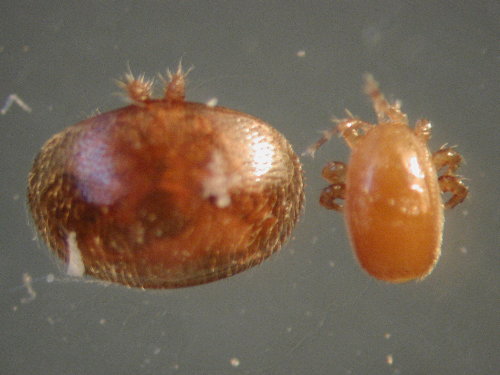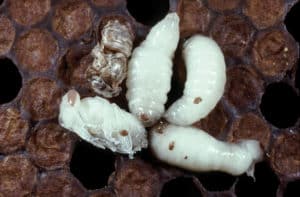Among the many diseases and pests that the APHIS National Honey Bee Survey samples are analyzed for is the exotic parasite, the Tropilaelaps mite. These mites are native to tropical Asia and are a serious threat to the honey bee. While they naturally use the giant honey bee (Apis dorsata) as their host, Tropilaelaps mites have easily transferred to the European honey bee and other Asian honey bee species; however fortunately for us, for the time being, they are not known to be found in the US.
Pictured here, the mites are reddish brown in a shade that is very similar to that of Varroa mites. They are about as 1/3 as wide as a Varroa mite, or 1mm long and 0.6mm. And are viewed scurrying over brood frames from cell to cell.

The majority of Tropilaelaps live and reproduce inside brood as they can achieve a longer life cycle there, living only about three days on an adult honey bee. Perhaps the most alarming characteristic of the mite is its reproduction rate and breeding cycle. Within 24 hours of hatching the mites enter another cell and begin reproduction, laying about four eggs at a time. One to four mites are generally found in a cell reproducing at one time; however there are reports of mites being found in quantities over three times that many in just one cell! They can quickly outnumber and out produce Varroa mites in colonies, hatching in only 12 hours and reaching full maturity in just six days.
If you have Tropilaelaps mites, they are the only thing you need to be concerned about to say the least. In comparison to Tropilaelaps, Varroa mites are no issue. Their damage to colonies is similar to that of the Varroa mite as they can cause developmental deformities, infections, and eventually death at a very rapid rate and because of their high reproduction rate they can multiply quicker than Varroa causing much more extensive damage.

Tropilaelaps focus mainly on attacking brood as their mouth parts are not strong enough to penetrate through an adult honey bee’s body as the Varroa mite can. The mites need a continuous brood cycle in order to keep up their rapid reproduction rate and stay alive. If there is more than a three day period in which there is no brood the mite will die, unlike the Varroa mite which can survive up to 25 days before it can no longer sustain life. In areas in which there is a break in the brood cycle Tropilaelaps can die, however in warm climates where the queen is continually laying the mites will continue to reproduce and spread at their rapid rate, transferring from hive to hive by way of one honey bee leaving a hive and entering another.
If Tropilaelaps were found in the US, the beekeeping industry would experience incredibly devastating losses that would seriously affect our agricultural industry and the impact would be felt around the country. The National Honey Bee Survey’s main goal is to sample wide and far to determine if this exotic mite has broached our borders. Right now, all samples indicate that these mites are absent in the US. This year, through taking a closer look at some ports with high international activity as well as continuing testing every sample for the mites we are hoping to continue to find no trace of these parasites in the US.